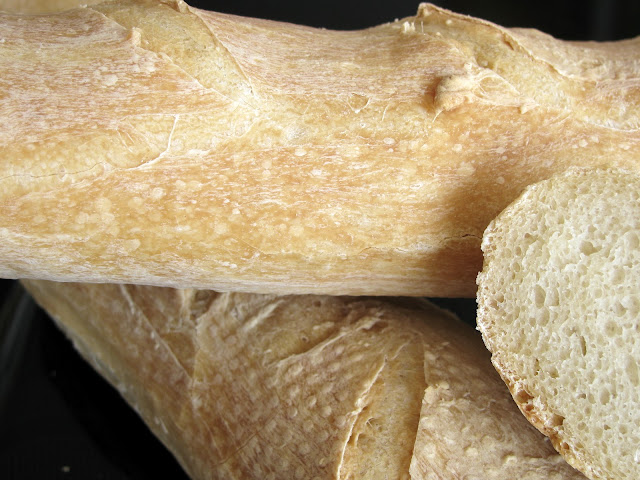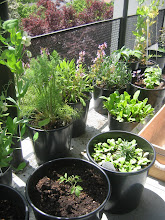Sunday, March 11, 2012
Back to the Baguettes
You know, I really was very happy with the way the original baguette recipe turned out. It was delicious. The thing is, I actually wanted to make a baguette like the ones you get at restaurants for putting cheese spread on. They're extra chewy, and they have holes in them. The original recipe didn't quite do that, besides being fiddly. So after all my other bread experiments, I returned to the idea of a baguette recipe for a lazy person.
1. Make the magic pizza dough recipe.
2. Let it lurk in the bottom of your fridge for a week. Really.
3. Preheat the oven to 470.
4. Poke the air out of the dough, but don't knead it.
5. Divide it in half, and pull and twist each half into a rope about 18" long.
6. Let them rise for about an hour.
7. Put them in the oven, and just before you close the door, pour about 1/4 cup of water on the floor of the oven.
8. No peeking for the next 20 minutes!
All those 'artisan bread' recipes, and all that hoopla, and all those arcane formulae, and all that nonsense? Totally unnecessary. The thing with dough is that if you mostly leave it alone, it will make itself! Just squish together the ingredients, let them sit around in the cold until they smell a little funny, let them poof up in a warm place, then cook them until the outsides are crunchy. Please try it, it's positively magical.
That was the enthusiasm part. Here's the slightly technical stuff. If you're feeling nervous, you don't need to read all the crap below, it's just me geeking out. As long as you follow the 8 steps above, you'll do just great.
- I cannot recommend a bread machine strongly enough. You put stuff in it, press a button and boop it makes dough. Awesome.
- You notice how much of this recipe is just waiting around. Yes, dough makes itself, but it does so in it's own good time. Fortunately, you can ignore it while it does its thing. I set myself a timer, or I will forget about it.
- The water on the oven floor is what makes the outsides of the baguette a little blistery and more chewy. I've heard some people recommend a couple ice cubes, but I don't have those in the winter. Why would I? It's cold out. In either case, it's important for the oven be very hot in order to turn the water into a cloud of steam, which means that:
- I really do want for you to have the oven on for an hour before you put anything in it, that isn't a mistake. For one thing, the stove top makes a nice warm place to proof the baguettes (do be aware that many ovens have a vent that comes out through one or the other of the back burners. This'll make a hot spot in that area, so make sure you don't put the dough right over it or you'll cook it to death), and for another, I'm assuming that you don't have a convection oven. My oven is a regular old not at all special electric, and leaving the oven on all that time ensures that the oven itself, not just the atmosphere inside it, is well hot before putting anything in there.
-This has to do with the behavior of ovens. An oven has a thermostat in it. That thing measures the temperature of the air inside the oven, and when the air temperature is up to say, 470, the oven says that it's pre-heated. Should be fine, right? Well, yes and no. When you open the oven, all that hot air flies out the door, and the temperature falls. That would happen no matter how long the oven had been on, but if the mass of the oven itself has not had time to accumulate heat, it will take much longer for the air inside it to return to the correct temperature, especially if you put a tray of relatively cold dough and a couple ice cubes in it. Moreover, after an hour, the heat is radiating off the whole oven evenly, not just off the oven elements on the floor. High, steady, even, heat and a shot of steam is what makes fancy looking bread.
- What if you don't want to wait a week for your bread? You can just leave the dough in a container on your counter overnight, instead of in the fridge, but this is slightly uncontrolled. In the winter, it works fine for me because the temperature of my house is pretty low at night. In the summer I think the dough would end up tasting pretty beery, because it gets really hot in here and the yeasts would go crazy in the heat for that long.
What did people do in the dark ages before they had instant yeast and refrigerators? Well, they woke up at 4 in the morning to catch the dough at the right stage of development, and they fiddled around with sourdough cultures which would get contaminated from time to time and wreck the bread, and pretty much had to make a profession of it for it to be worthwhile. Baker is not a noble family name, but it is a respectable one, I think.
Subscribe to:
Post Comments (Atom)









No comments:
Post a Comment